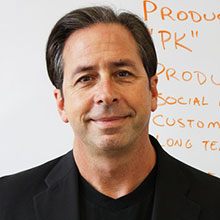
Pabini: In a nutshell, how would you define UX strategy?
Paul: UX strategy is about building a rationale to guide UX design efforts for the foreseeable future. UX strategy communicates a vision, priorities, design direction, and roadmap to serve as a North Star for all of the people in an organization who are planning and building digital products and programs. UX strategy is fundamentally based on data, but also encompasses creative leaps that let teams innovate and adapt to rapidly evolving technology contexts.
Pabini: Tell me about how you came to be a UX Strategist. What aspects of your education and professional background led you to a career in UX strategy?
Paul: I started designing Web sites in Barcelona in 1996. I was on a steady course as a UX Architect, having worked in that capacity for Sapient until 2002, then in my own consulting practice. In 2009, I had the privilege of working closely with a Business Strategist for a large retailer for six months, putting together a UX strategy foundation and roadmap that deeply integrated user experience vision, concept, design, and planning with business strategy and operational plans. That experience was both challenging and extremely satisfying, so I started seeking out similarly strategic engagements in my consulting practice.
Pabini: For people who want to pursue a career in UX strategy, what are the mindset and skills that a UX Strategist should have?
Paul: UX Strategists need to have a strong background in UX design and a deep understanding of their company, its customers, and its competition. I wrote about this in a UX Strategy column for UXmatters titled “3 Keys to Aligning UX with Business Strategy.” UX Strategists need to have a firm grasp of their company’s goals, priorities, and plans at a detailed level. They need to have a clear understanding of their customers’ interactive behavior patterns and how those patterns are evolving across various digital channels and touchpoints. And they need to understand the market context in which their digital products are competing.
Pabini: What prompted you to start the UX Strategy and Planning (UXS&P) group on LinkedIn?
Paul: I had completed a series of consulting engagements that were directly related to UX strategy and realized that this was a direction that I wanted to pursue professionally. My colleagues told me that this topic was too small a niche for a group, but I was convinced that UX strategy would be a significant growth area for user experience—a path away from the commoditization of UX skills that seemed imminent with increasing globalization and the improvement of automated tools.
Pabini: Tell me about the community that’s evolved from the UXS&P group. Do you or other members of the UXS&P community have any plans to create a more formal UX Strategy organization?
Paul: Last year, I formed a consulting group that brings together experienced talent for UX strategy consulting engagements and cleverly named it the UX Strategy Group.![]() But rather than starting a formal UX strategy organization, I’m currently more interested in helping existing organizations like the UXPA to serve the needs of UX Strategists and develop a strong vertical offering in the area of UX strategy. The UXPA has given its active support to UX STRAT from its inception. The formation of a more targeted UX Strategy organization may be warranted at some time in the future, but for now, I think the best approach is to support an integrated offering rather than creating another specialty silo. We need to understand what everyone else in user experience is doing to be effective UX Strategists.
But rather than starting a formal UX strategy organization, I’m currently more interested in helping existing organizations like the UXPA to serve the needs of UX Strategists and develop a strong vertical offering in the area of UX strategy. The UXPA has given its active support to UX STRAT from its inception. The formation of a more targeted UX Strategy organization may be warranted at some time in the future, but for now, I think the best approach is to support an integrated offering rather than creating another specialty silo. We need to understand what everyone else in user experience is doing to be effective UX Strategists.
Pabini: What made you decide to organize the UX STRAT 2013 conference?
Paul: If you scan the discussion topics in the UX mega-groups on LinkedIn, then scan the topics in the UX Strategy and Planning group, I think you’ll see why the people who are interested in UX strategy were not getting what they needed from generalist UX conferences. If your goal is to figure out the smartest way to guide a large digital product or program, with visitors and revenues measuring in the millions, discussing the best prototyping tool or Photoshop filters or form-field patterns is just not going to cut it.
I felt that UX professionals who are responsible for establishing a vision, developing priorities, and creating a roadmap for future user experiences needed their own forum for discussing frameworks and case studies that would help them improve their chances for success.
Pabini: What are your goals for the conference?
Paul: My main goal for UX STRAT 2013 is that the presentations and workshops provide a comprehensive foundation for the emerging, global practice of UX strategy. I realize that may sound pretentious to some and overly ambitious to others. Nevertheless, I think UX strategy offers a sorely needed guiding light for establishing a vision and direction for the massive number of UX design efforts taking place around the world.
Developing a UX strategy for a project is a North Star of sorts that can lead to the alignment of user experience with business strategy, a vision of where a digital product is going, the ability to measure its progress, and ultimately, a greater likelihood of a successful customer experience. I’m hoping that UX STRAT 2013 will be a platform where emerging leaders in the new discipline of UX strategy can share their ideas and methods. I hope the seeds we plant there can grow into a fully developed profession in both small and large companies.
